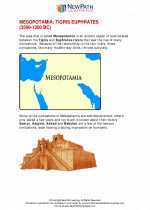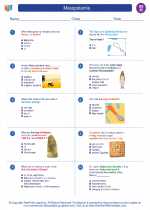Mesopotamia
The area that is called Mesopotamia is an ancient region of land located between the Tigris and Euphrates rivers that saw the rise of many civilizations. Because of the relationship to the two rivers, these civilizations, like many modern-day cities, thrived culturally. The Sumerians are credited with the creation of the first system of writing, irrigation, an advanced knowledge of mathematics, and the twelve month calendar. Read More...
◂Social Studies Worksheets and Study Guides Eighth Grade. Mesopotamia
Study Guide Mesopotamia
Mesopotamia  Worksheet/Answer key
Worksheet/Answer key Mesopotamia
Mesopotamia  Worksheet/Answer key
Worksheet/Answer key Mesopotamia
Mesopotamia  Worksheet/Answer key
Worksheet/Answer key Mesopotamia
Mesopotamia 

 Worksheet/Answer key
Worksheet/Answer key
 Worksheet/Answer key
Worksheet/Answer key
 Worksheet/Answer key
Worksheet/Answer key

The resources above cover the following skills:
National Curriculum Standards for Social Studies (NCSS)
TIME, CONTINUITY, AND CHANGE
SOCIAL STUDIES PROGRAMS SHOULD INCLUDE EXPERIENCES THAT PROVIDE FOR THE STUDY OF THE PAST AND ITS LEGACY.
KNOWLEDGE - Learners will understand:
Key historical periods and patterns of change within and across cultures (e.g., the rise and fall of ancient civilizations, the development of technology, the rise of modern nation-states, and the establishment and breakdown of colonial systems).
National Center for History in Schools (NCHS)
Historical Thinking Standards
Historical Comprehension
Reconstruct the literal meaning of a historical passage.
World History Content Standards
Era 2: Early Civilizations and the Emergence of Pastoral Peoples, 4000-1000 BCE
The major characteristics of civilization and how civilizations emerged in Mesopotamia, Egypt, and the Indus valley.
The student understands how Mesopotamia, Egypt, and the Indus valley became centers of dense population, urbanization, and cultural innovation in the fourth and third millennia BCE.
The student understands how commercial and cultural interactions contributed to change in the Tigris-Euphrates, Indus, and Nile regions.
How agrarian societies spread and new states emerged in the third and second millennia BCE.
The student understands how new centers of agrarian society arose in the third and second millennia BCE.
Major trends in Eurasia and Africa from 4000-1000 BCE.
The student understands major trends in Eurasia and Africa from 4000 to 1000 BCE.